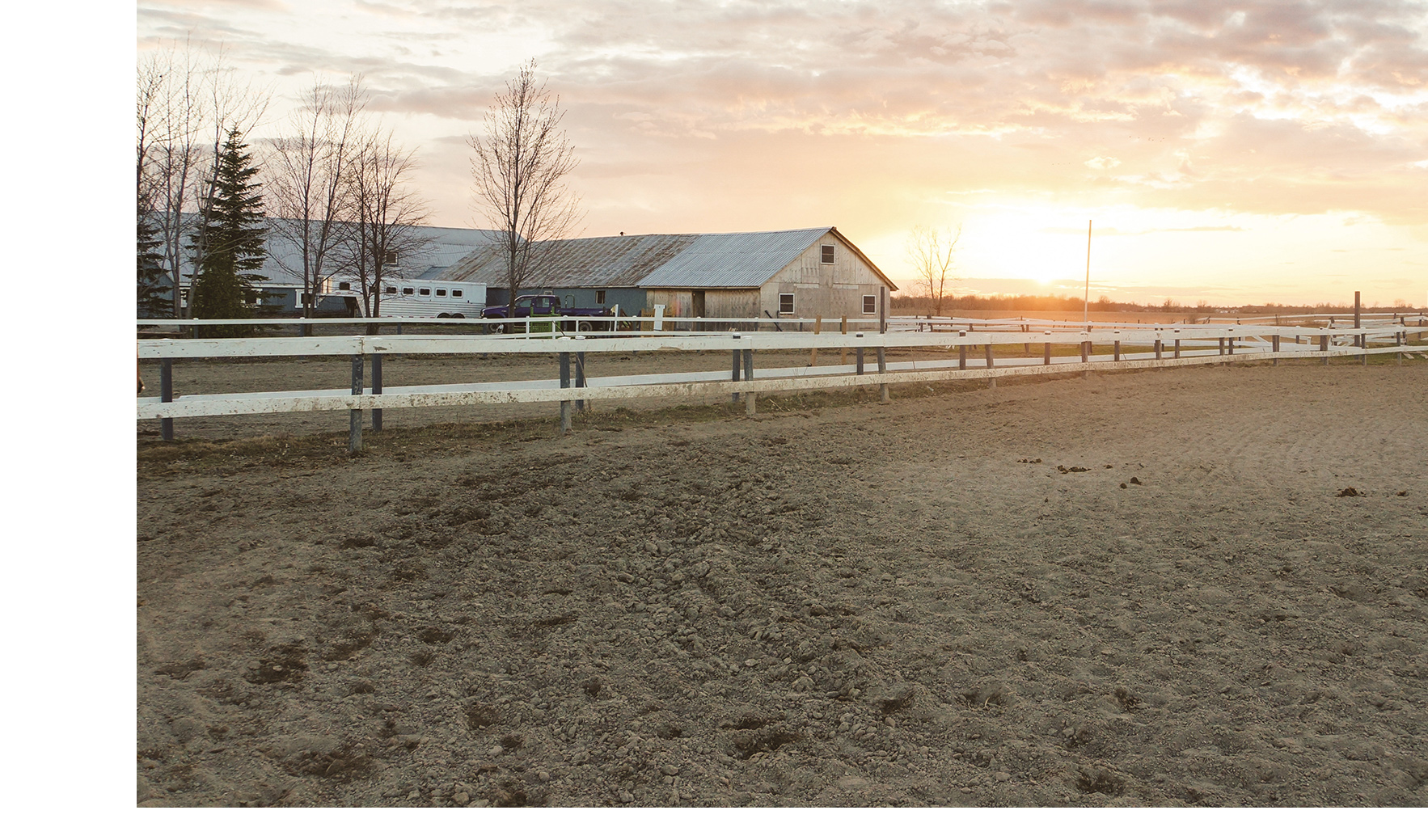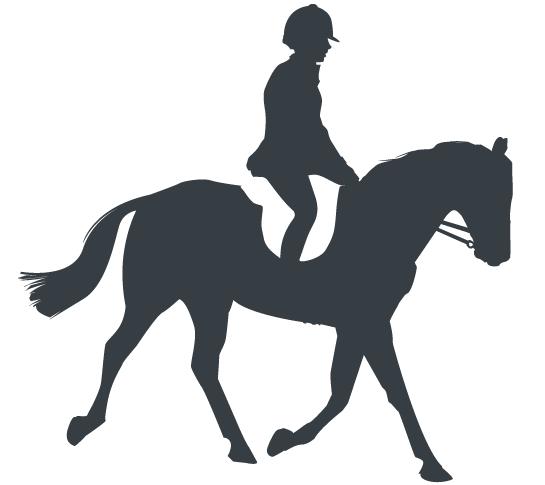Head injury is one of the most common types of horseback riding injury, either due to a fall or from being kicked by the horse.

Horseback riding is governed locally by Horse Council BC. Equestrian events at the Olympic Games are both individual and team events, including dressage, eventing, and show jumping, with men and women competing together. The large stature (~1,100 pounds and 6 feet tall on average) and unpredictability of a horse is associated with a high risk for both fall-related injury and injury from being kicked by the animal when standing near it.
(see Section 04 - Prevention)
Head injury is one of the most common types of horseback riding injury, either due to a fall or from being kicked by the horse.
Recreational riders tend to sit with an upright posture instead of in a forward-leaning position. Falls from a horse while in an upright posture are more likely to have an impact on the pelvis, the thoracic spine, and the lumbar spine.
Arm fractures are common injuries in horseback riding.
Leg injuries can occur in horseback riding.
The majority of injuries in horseback riding occur to the head, trunk, and upper extremities. Predominant types of injury include head injury, fracture, and soft tissue injury. Head injury accounts for 50% of horse-related injuries leading to hospitalization. Limb fractures account for approximately 18% of injuries among show jumpers, 40% of injuries among Swedish eventing athletes, and 42.5% of career-ending injuries among horse racing jockeys. Falls or being thrown are the most common injury mechanism while mounted, while being kicked is the most common mechanism of injury when standing near a horse. Other injuries can be caused by trampling/crushing and by being bitten by the horse.
It is estimated that...

Factors that increase the risk of injury during horseback riding include: rider age, sex and experience, events, and racing.
Riders ages 10 to 29 years have the highest rates of injury. Rates of falling from a horse increase with age. In hurdle racing, higher jockey age is associated with a 40% higher risk of fall resulting in injury.
Riders with less than 3 years of experience have a 3 times higher risk of overall injury than intermediate riders, 5 times higher risk than advanced riders, and 8 times higher risk than professional riders. Professional riders have a higher risk of severe injury.
An increased risk of falls in steeplechase racing is associated with License B jockeys, larger field size, longer race distance, and higher club level. Previous rides in the meeting and lower prize money at stake are protective against the risk of falls, reducing the risk by 30% and 59%, respectively.
Females are at a 10% higher risk of falls as compared to males.
Two- and three-day events are associated with a higher risk of a fall compared to one-day events.
An increased risk of falls resulting in injury is associated with License B jockeys, larger field size, higher club level, higher race grade, and older rider age.
Some muscle soreness or joint pain is expected when increasing your level of physical activity. It is important to listen to your body for persistent or worsening pain, and to know when to rest. Learn more about how to prevent injuries in horseback riding.
Talk to your coach or organization about the prevention strategies below and how they might be incorporated into training and policies.
The use of protective riding helmets has been associated with a five times reduction in head injury.
As head injuries are common in horseback riding, it is important to be aware of concussion signs and symptoms and know what to do if concussion is suspected. The Concussion Awareness Training Tool (CATT) is an online resource for riders and parents to learn more about how to recognize, prevent, and manage a concussion. CATT also includes resources on how to respond to a potential concussion situation, as well as detailed Return to School and Return to Sport protocol.
Oslo Sport Trauma Research Centre Neuromuscular Training
The Oslo Sport Trauma Research Centre has developed exercises that specifically help keep the body strong and reduce the risk injury. This resource includes videos and PDFs for download.
For more exercises, visit http://fittoplay.org/
Get Set Neuromuscular Training
The Get Set app is a great resource to find exercises to build strength and reduce the chances of being injured during horseback riding activities. You can search by body part to view exercises that work to strengthen each area of the body, or you can search by sport to view a whole library of exercises that are specific to equestrian or modern pentathlon events.
Download Get Set for Android.
Download Get Set for iOS.
Sleep, Vigilance and Sport Injury Prevention
Being successful in physical activity requires a high degree of alertness, also known as vigilance. Sufficient sleep helps your body to recover, allows you to achieve your goals, and reduces your risk of injury. Getting less than 8 hours of sleep can increase your rate of injury by up to 70%! Watch this video to learn more about how sleep and vigilance are connected.
Sport-related Physicals
Horseback riding is a physically demanding sport and some pre-existing conditions may increase the risk of injury. An annual sport-related physical evaluation ensuring fitness can help to reduce risk of injury. KidsHealth provides information about what sports physicals are, why they may be appropriate and where you may go to get them.
Learn more about Kids Health Sports Physicals.
Additional Resources
Horse Council British Columbia provides safety information, including helmet use and concussion awareness.
Ontario Equestrian provides information on their concussion policy, including the recommendations for helmet use.
BrainLine is a U.S. resource for preventing traumatic brain injury, including information on equestrian safety.
Talk to your organization or school about the prevention strategies below and how they might be incorporated into training and policies.
The use of protective riding helmets has been associated with a five times reduction in head injury
As head injuries are common in horseback riding, it is important to be aware of concussion signs and symptoms and know what to do if concussion is suspected. The Concussion Awareness Training Tool (CATT) is an online resource for coaches and teachers to learn more about how to recognize, prevent, and manage a concussion. CATT also includes resources on how to respond to a potential concussion situation, as well as detailed Return to School and Return to Sport protocol.
Oslo Sport Trauma Research Centre Neuromuscular Training
The Oslo Sport Trauma Research Centre has developed exercises that specifically help keep the body strong and reduce the risk injury. This resource includes videos and PDFs for download.
For more exercises, visit http://fittoplay.org/.
Get Set Neuromuscular Training
The Get Set app is a great resource to find exercises to build strength and reduce the chances of being injured during horseback riding activities. You can search by body part to view exercises that work to strengthen each area of the body, or you can search by sport to view a whole library of exercises that are specific to equestrian or modern pentathlon events.
Download Get Set for Android.
Download Get Set for iOS.
Sport-related Physicals
Horseback riding is a physically demanding sport and some pre-existing conditions may increase the risk of injury. An annual sport-related physical evaluation ensuring fitness can help to reduce risk of injury. KidsHealth provides information about what sports physicals are, why they may be appropriate and where you may go to get them.
Learn more about Kids Health Sports Physicals.
Additional Resources
Horse Council British Columbia provides safety information, including helmet use and concussion awareness.
Ontario Equestrian provides information on their concussion policy, including the recommendations for helmet use.
BrainLine is a U.S. resource for preventing traumatic brain injury, including information on equestrian safety.
Talk to your coaches, teachers, organization, or school about the prevention strategies below and how they might be incorporated into training and policies.
The use of protective riding helmets has been associated with a five times reduction in head injury.
As head injuries are common in horseback riding, it is important to be aware of concussion signs and symptoms and know what to do if concussion is suspected. The Concussion Awareness Training Tool (CATT) is an online resource to learn more about how to recognize, prevent, and manage a concussion. CATT also includes resources on how to respond to a potential concussion situation, as well as detailed Return to School and Return to Sport protocol.
Oslo Sport Trauma Research Centre Neuromuscular Training
The Oslo Sport Trauma Research Centre has developed exercises that specifically help keep the body strong and reduce the risk injury. This resource includes videos and PDFs for download.
For more exercises, visit http://fittoplay.org/.
Get Set Neuromuscular Training
The Get Set app is a great resource to find exercises to build strength and reduce the chances of being injured during horseback riding activities. You can search by body part to view exercises that work to strengthen each area of the body, or you can search by sport to view a whole library of exercises that are specific to equestrian or modern pentathlon events.
Download Get Set for Android.
Download Get Set for iOS.
Sport-related Physicals
Horseback riding is a physically demanding sport and some pre-existing conditions may increase the risk of injury. An annual sport-related physical evaluation ensuring fitness can help to reduce risk of injury. KidsHealth provides information about what sports physicals are, why they may be appropriate and where you may go to get them.
Learn more about Kids Health Sports Physicals.
Additional Resources
Horse Council British Columbia provides safety information, including helmet use and concussion awareness.
Ontario Equestrian provides information on their concussion policy, including the recommendations for helmet use.
BrainLine is a U.S. resource for preventing traumatic brain injury, including information on equestrian safety.
The role of health professionals in preventing horseback riding injuries has two main components:
The use of protective riding helmets has been associated with a five times reduction in head injury.
As head injuries are common in horseback riding, it is important to be aware of concussion signs and symptoms and know what to do if concussion is suspected. The Concussion Awareness Training Tool (CATT) is an online resource to learn more about how to diagnose and manage a concussion. CATT also includes resources on how to assess a potential concussion, as well as detailed Return to School and Return to Sport protocol.
Oslo Sport Trauma Research Centre Neuromuscular Training
The Oslo Sport Trauma Research Centre has developed exercises that specifically help keep the body strong and reduce the risk injury. This resource includes videos and PDFs for download.
For more exercises, visit http://fittoplay.org/.
Get Set Neuromuscular Training
The Get Set app is a great resource to find exercises to build strength and reduce the chances of being injured during horseback riding activities. You can search by body part to view exercises that work to strengthen each area of the body, or you can search by sport to view a whole library of exercises that are specific to equestrian or modern pentathlon events.
Download Get Set for Android.
Download Get Set for iOS.
Sport-related Physicals
Horseback is a physically demanding sport and some pre-existing conditions may increase the risk of injury. An annual sport-related physical evaluation ensuring fitness can help to reduce risk of injury. The American Academy of Pediatrics provides information about preparticipation physical evaluation.
Learn more about Preparticipation Physical Evaluation.
Additional Resources
Horse Council British Columbia provides safety information, including helmet use and concussion awareness.
Ontario Equestrian provides information on their concussion policy, including the recommendations for helmet use.
BrainLine is a U.S. resource for preventing traumatic brain injury, including information on equestrian safety.
